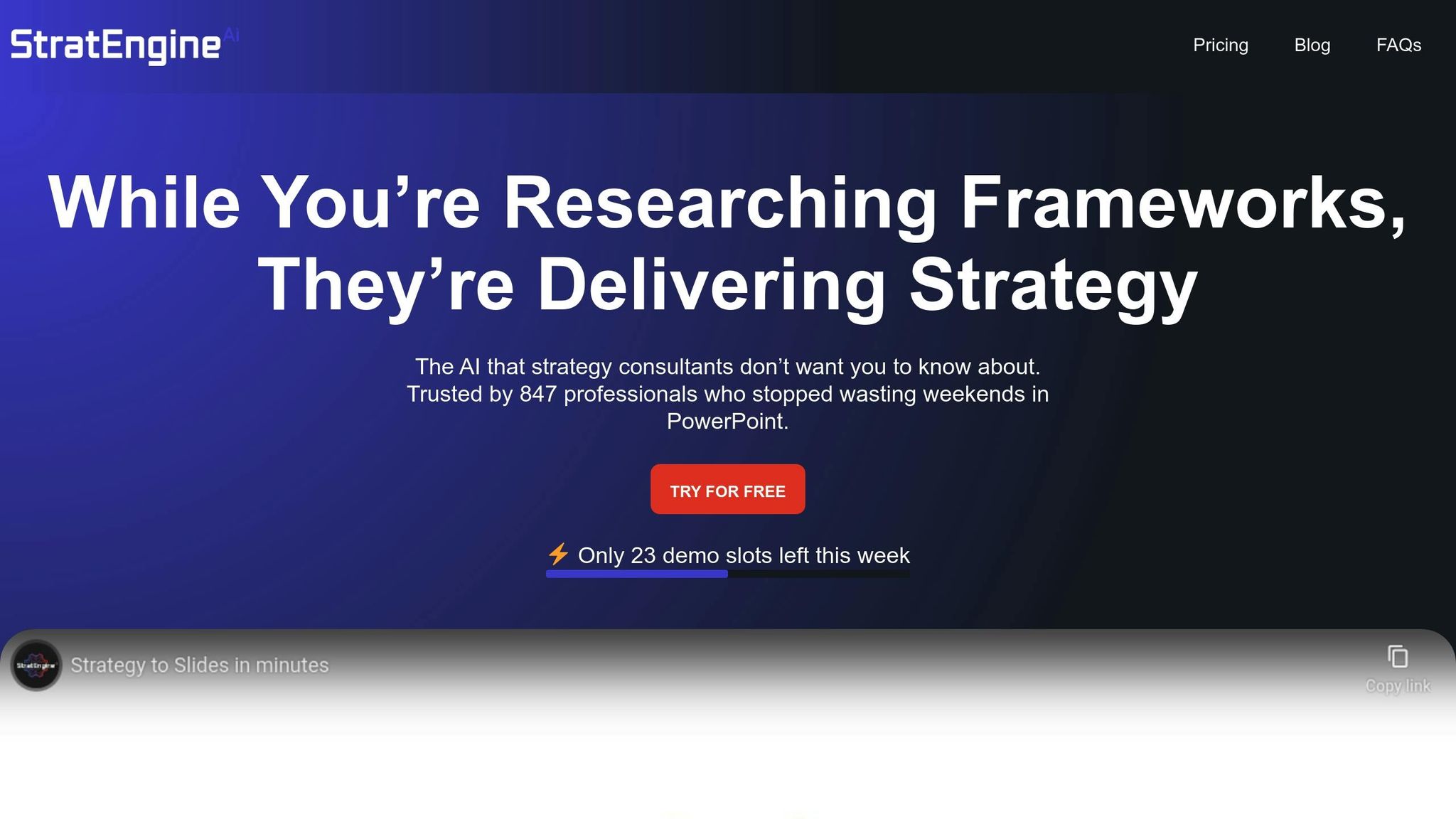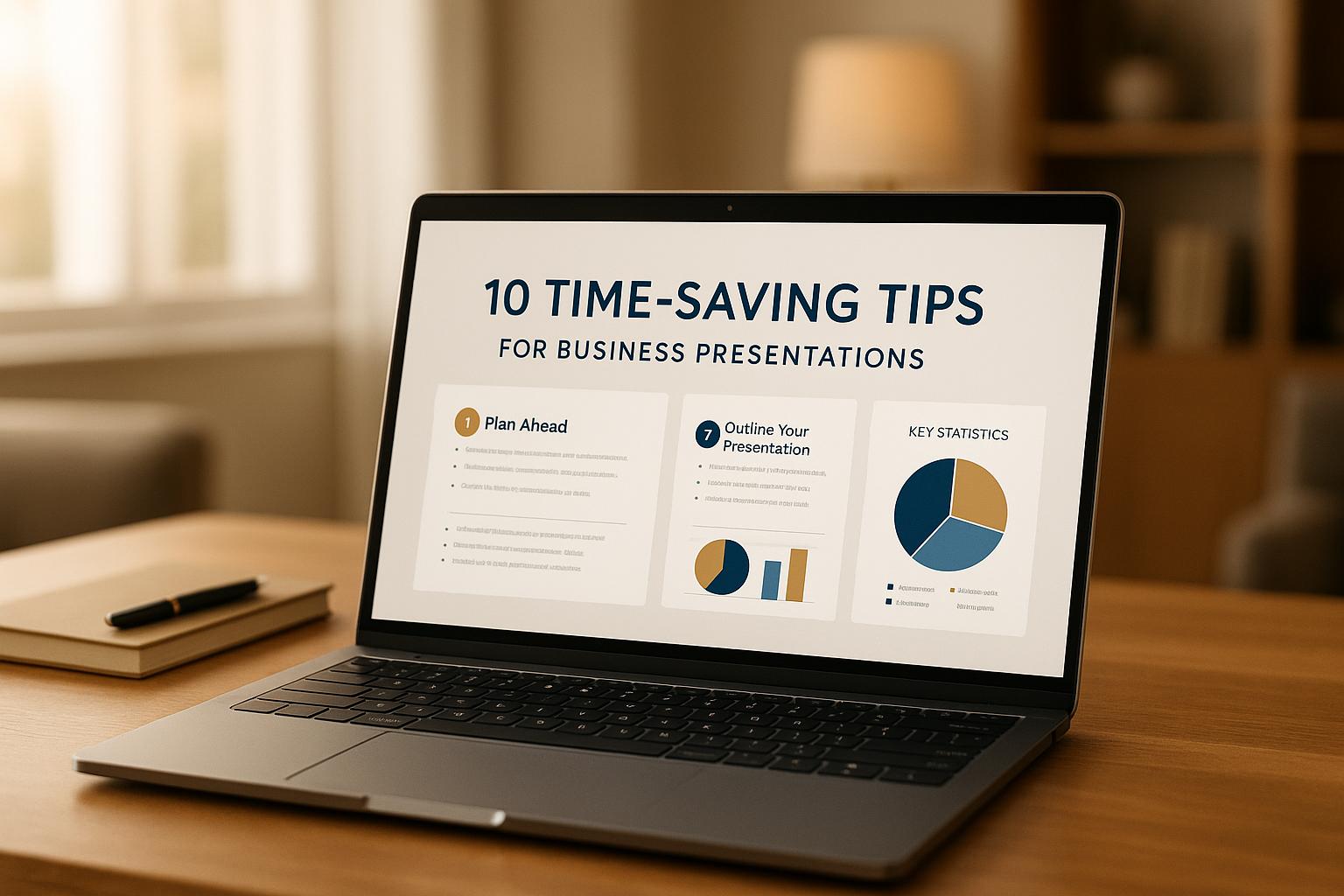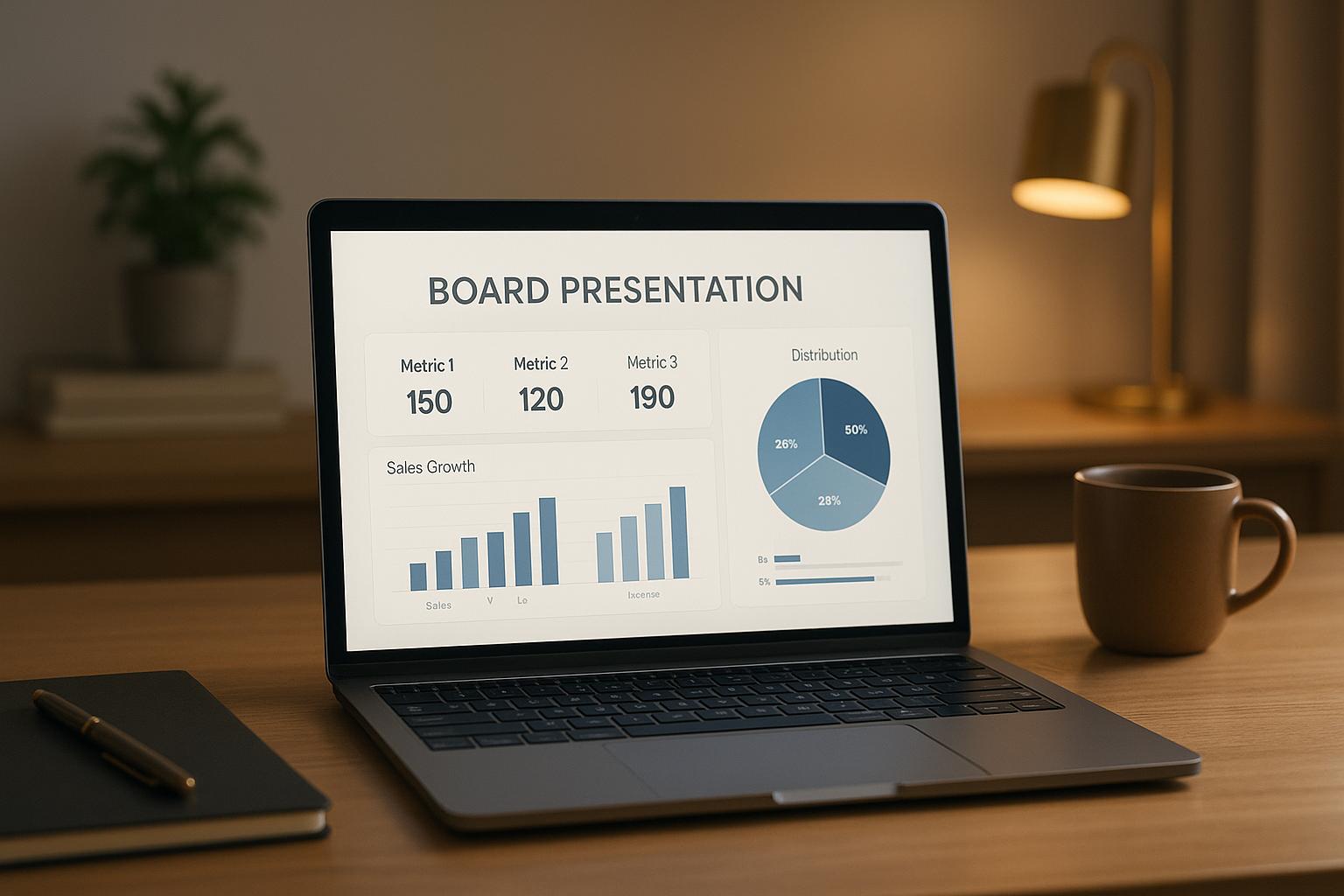AI scenario planning tools are transforming how businesses approach decision-making by automating complex analyses and modeling multiple potential futures. Unlike single-outcome forecasting, these tools evaluate a wide range of possibilities, helping companies respond faster to market changes and risks. Here's what you need to know:
- Key Features: Tools like StratEngineAI use AI to generate detailed strategic briefs based on established frameworks (e.g., SWOT, Porter’s Five Forces) and produce professional presentations in minutes. They also integrate with data systems for real-time insights.
- Benefits: Faster decision-making, risk assessment, and actionable insights backed by data.
- Scalability: Suitable for small teams or large enterprises, with options for free trials and flexible deployment.
When choosing a platform, prioritize tools that align with your data needs, offer clear reporting, and support quick, informed decisions.
Scenario Planning in Uncertain Times: Using AI and Tools to Stay Ahead
1. StratEngineAI

StratEngineAI is an AI-driven strategic planning platform designed to simplify and speed up the planning process. From initial research to final delivery, it handles the entire workflow, making it a go-to tool for executives who need to develop scenarios quickly.
AI Capabilities
At its core, StratEngineAI uses advanced AI to create strategic briefs packed with insights like market analysis, competitive intelligence, and actionable recommendations. These briefs are structured using over 20 well-known strategic frameworks, including SWOT, Porter’s Five Forces, and Blue Ocean Strategy. By leveraging these established methodologies, the platform ensures strategic planning stays on track while cutting down the time it usually takes to build detailed strategy presentations. It also automates the creation of multiple scenarios, offering users a range of options to consider. All this data is presented in a way that's both intuitive and easy to interpret.
Reporting and Visualization
One of StratEngineAI’s standout features is its ability to produce professional-grade strategy decks instantly. These polished presentations are ready for boardroom discussions, bridging the gap between detailed analysis and clear, actionable insights for stakeholders.
Scalability
StratEngineAI adapts to a variety of needs with flexible access options, including a free trial. This trial allows businesses to upload their challenges, generate strategy decks, and explore the platform’s key features before making a commitment. Whether it’s a single project or a company-wide initiative, the platform can handle it all, generating as many strategy decks as needed. Its versatility makes it an excellent choice for consulting firms and large organizations juggling complex planning demands, ensuring fast and efficient decision-making across the board.
2. Alternative AI Scenario Planning Platform
When looking beyond the well-known platforms for AI scenario planning, it’s crucial to know what makes a tool truly effective. While many options claim to provide AI-driven strategic planning, only a few deliver the features needed for meaningful decision-making. The best tools go beyond basic automation, offering capabilities that genuinely enhance strategic insights.
AI Capabilities
Modern AI scenario planning tools rely on machine learning to sift through vast amounts of market data and create a variety of potential scenarios. They also use natural language processing to analyze industry reports, news, and competitive intelligence, allowing them to adjust assumptions as market conditions evolve.
The strongest platforms can generate scenarios that factor in probabilities and risks, offering a more nuanced view of potential outcomes. Advanced features include the ability to cross-reference multiple data sources and detect patterns that might escape human analysts. For example, these tools can process financial data, market trends, regulatory updates, and shifts in consumer behavior to build well-rounded scenario models. Additionally, the AI should learn from past scenarios, improving its accuracy and usefulness over time.
Data Integration
A key feature of any effective scenario planning tool is seamless data integration. The best platforms connect directly with enterprise resource planning (ERP) systems, customer relationship management (CRM) databases, and external data feeds. This allows the tools to work with real-time data instead of relying on outdated, static datasets.
Top-tier tools also support API connections with major business intelligence platforms, enabling automatic data pulls from financial systems, sales databases, and market research sources. By eliminating the need for manual data entry, these integrations ensure that scenarios are built on accurate and up-to-date information. This integrated approach feeds into detailed reporting features, making complex insights easier to understand and act upon.
Reporting and Visualization
High-quality platforms excel at turning complex data into clear, actionable insights. They provide interactive dashboards and customizable templates that help users present strategic findings effectively. These visualizations - featuring charts, graphs, and strategic frameworks - make it easier to communicate intricate ideas to executives and stakeholders.
Export options for popular presentation formats ensure that strategic recommendations can be easily shared across teams and departments. This functionality is critical for organizations that need to align quickly on key decisions.
Scalability
For enterprise-level scenario planning, scalability is a must. The best platforms can handle multiple scenario requests simultaneously, which is especially valuable for consulting firms and large corporations juggling numerous strategic projects across various units.
Cloud-based systems often offer the flexibility needed to scale operations up or down based on demand. These tools should also support multi-user environments, complete with access controls and collaboration features. Pricing structures should cater to different needs, from individual consultants to large enterprises requiring significant computational power.
For organizations with strict data security requirements, on-premises deployment options are also important. The ability to process large datasets and run complex models without performance issues ensures that teams can maintain productivity during high-pressure planning cycles. This scalability is what allows organizations to use scenario planning effectively at every level, from small teams to large-scale operations.
sbb-itb-7250072
Comparison Summary
When evaluating AI scenario planning tools, two critical factors often come into play: the methodology they use and how quickly they deliver results. StratEngineAI sets itself apart by utilizing more than 20 well-established strategic frameworks - like SWOT, Porter’s Five Forces, and Blue Ocean Strategy - to automatically produce detailed strategic briefs in just a few minutes. This structured approach ensures that executives and consultants receive polished, decision-ready outputs without the lengthy timelines typically associated with traditional strategy processes.
Here’s a quick breakdown of how StratEngineAI stacks up against other tools:
| Feature | StratEngineAI | Other Tools |
|---|---|---|
| Strategic Frameworks | Over 20 established frameworks (e.g., SWOT, Porter’s Five Forces) | Varies widely, with inconsistent methodologies |
| Speed | Generates strategic briefs in minutes | Timing depends on the platform |
| Reporting | Instant export of professional-grade presentations | Reporting capabilities differ across platforms |
| Target Audience | Tailored for executives and consultants seeking fast insights | Designed for a broader range of users |
| Automation | Fully automated, from research to presentation | Automation levels vary |
StratEngineAI’s ability to deliver fast, framework-based strategic insights makes it a valuable tool for organizations needing quick, reliable decisions. While other tools may offer diverse approaches, StratEngineAI’s focus on efficiency and structure ensures it meets the demands of time-sensitive projects.
If rapid, framework-driven insights are your priority, StratEngineAI is built to empower confident decision-making in record time.
Final Recommendations
When selecting an AI scenario planning tool, it's important to align your choice with your specific needs and timeline. Think about how quickly you need results, the level of analysis required, and your team's expertise. Here’s a closer look at some key factors to keep in mind.
StratEngineAI stands out for delivering quick, presentation-ready insights grounded in established strategic frameworks. This means you get results fast, without sacrificing quality or sound methodology. Its ability to generate detailed strategic briefs in just minutes makes it especially useful for addressing urgent decisions or time-sensitive challenges.
For organizations with more complex planning requirements, prioritize tools that integrate seamlessly with your existing systems - such as business intelligence platforms, CRM databases, and financial planning tools. This ensures your data flows smoothly and supports more comprehensive analysis.
If you’re considering StratEngineAI, take advantage of their free trial. It’s a practical way to explore the platform’s framework-driven approach before committing to a full rollout.
Whether you’re a small business or a large corporation, StratEngineAI adapts to your scale and needs. Smaller teams will appreciate its automation features, which save time and effort, while larger enterprises can benefit from its ability to instantly export polished, professional presentations.
Lastly, assess your team’s familiarity with common strategic frameworks like SWOT or Porter’s Five Forces. Familiarity with these tools can significantly reduce training time and help your team start using the platform effectively right away.
FAQs
How do AI scenario planning tools improve decision-making speed and accuracy compared to traditional forecasting methods?
AI-powered scenario planning tools stand out for their impressive speed and precision, thanks to advanced algorithms that can sift through massive datasets in record time. They provide real-time insights, enabling businesses to react swiftly to market shifts and make smarter, more informed decisions.
What sets these tools apart from traditional forecasting methods is their ability to adjust dynamically to new data. Traditional models often rely heavily on static frameworks and past trends, which can quickly become outdated. In contrast, AI tools continuously update their forecasts, ensuring they stay relevant and accurate. This dynamic approach not only minimizes errors but also boosts operational flexibility, giving executives the confidence to act decisively and efficiently.
What strategic frameworks does StratEngineAI use, and how do they support scenario planning?
StratEngineAI integrates key strategic frameworks such as Porter’s Five Forces, Blue Ocean Strategy, SWOT Analysis, and the Strategy Diamond to simplify and organize scenario planning. These tools help break down intricate strategic issues, highlight competitive advantages, reveal unexploited market opportunities, and deliver actionable insights to support smarter decision-making.
By applying these well-established methods, StratEngineAI allows for quicker and more efficient scenario assessments without compromising the thoroughness and precision that executives and consultants rely on for crafting successful strategies.
What factors should businesses consider when integrating AI scenario planning tools with their existing data systems?
To make sure AI scenario planning tools work smoothly with your existing data systems, the first step is to focus on data quality and compatibility. Ensure your data is clean, well-organized, and easy for the AI tool to process. It’s just as important to select an AI platform that aligns with your current systems and workflows - this helps prevent unnecessary disruptions.
Another crucial aspect is setting up clear data governance protocols. These protocols safeguard security, ensure compliance, and preserve data integrity. Automating data pipelines can streamline processes, while encouraging collaboration between human analysts and AI systems can lead to quicker and smarter decisions. By concentrating on these areas, businesses can harness the full power of AI while continuing to deliver dependable, actionable insights.


